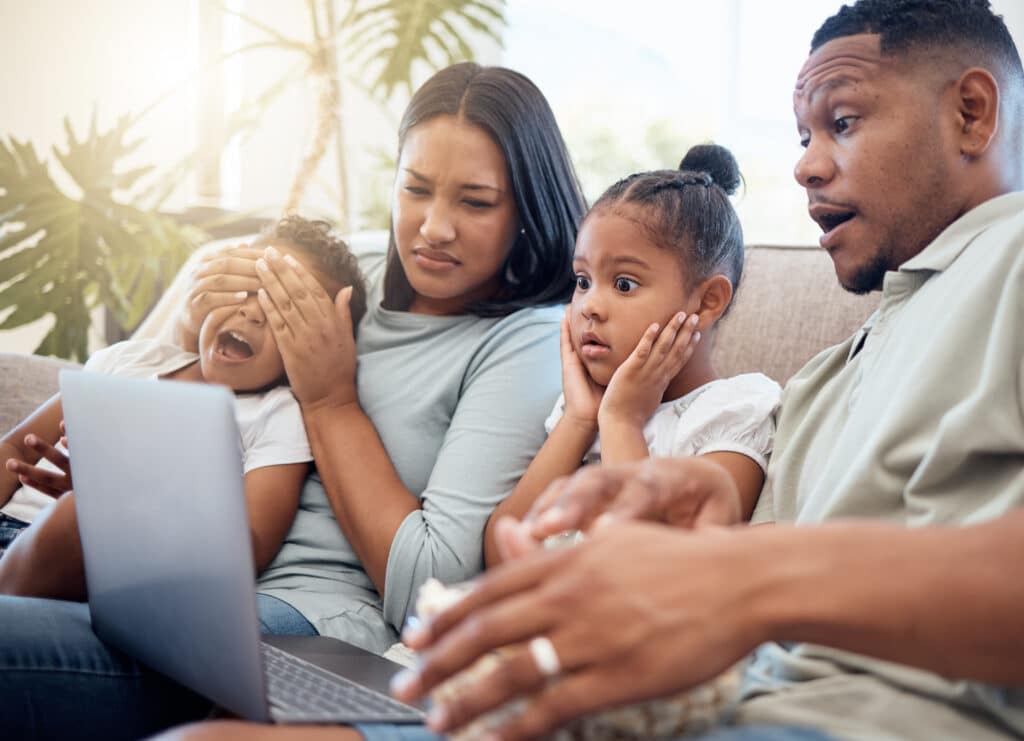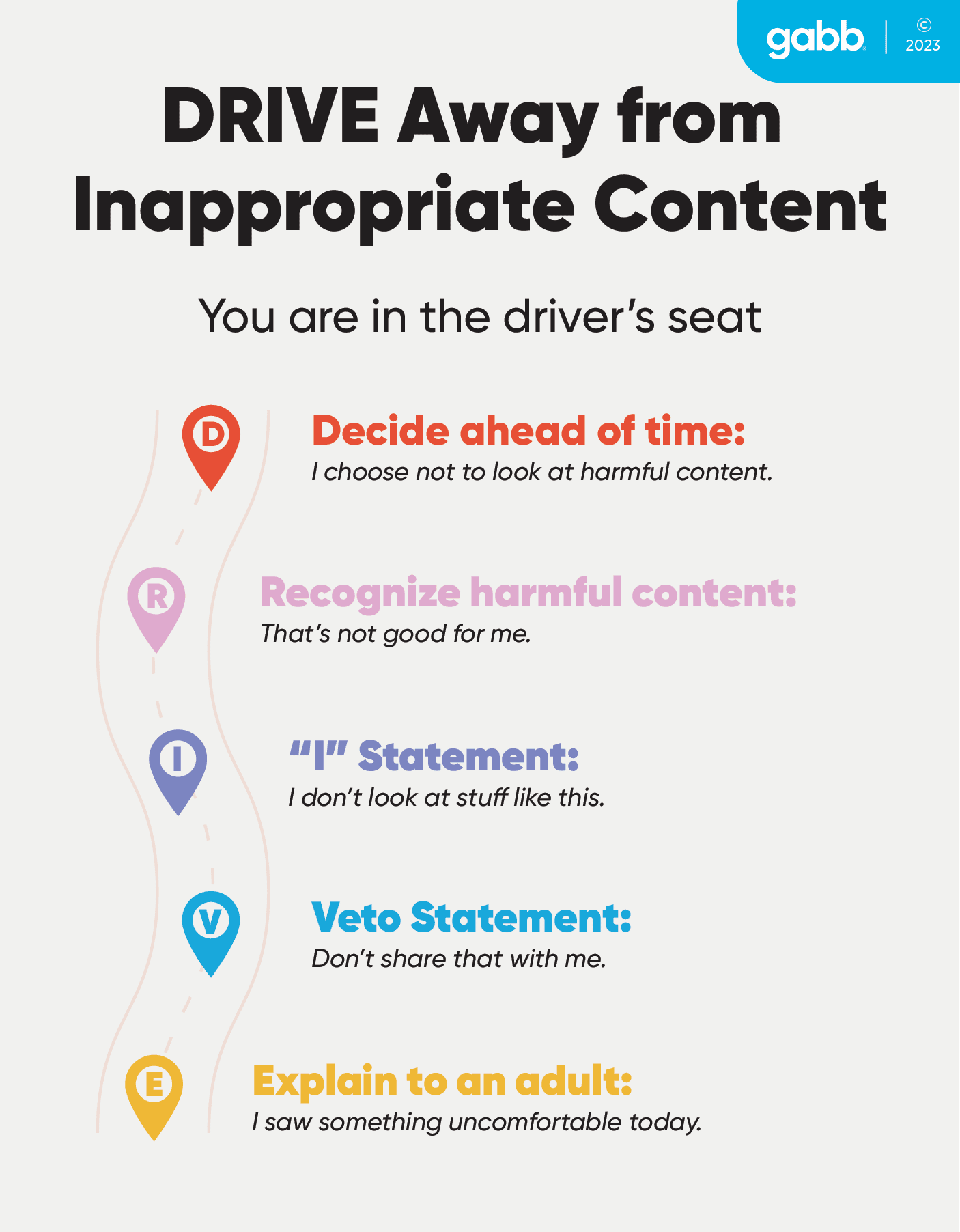We all want our children to have good friends. The kind of friends that bring them happiness, laughter, and support. Every family has different standards, so what happens when a friend or teammate shares with our kids something we consider inappropriate? How do we hope our kids will react? How can we prepare them to act with confidence?
This can be an uncomfortable situation to be in, but also a great teaching opportunity. We can empower our children to navigate these situations successfully.

What is Considered Inappropriate Content?
Families have different views on what is inappropriate. For instance, some may feel like their young child is mature enough to watch movies rated PG-13, and others may feel that their children should wait until their teens. Every family is different with unique standards, and that’s ok.
Inappropriate content in this article refers to anything that makes the child feel uncomfortable or is against the family’s standards.

Dangers of Explicit Content
Parents can deem things inappropriate when they feel their child is too young or immature for it, or when the content is aimed at adults.
A study of 1000 parents asked them to rate eight movie clips containing sexual content and strong violence based on what age it would be suitable for. The sequence of clips varied between participants. As parents watched, their ratings started off conservatively with more attention to strong content, and then gradually the recommended age lowered with each clip, even when the last clip contained more graphic content than the first. [1]
The problem with inappropriate content is that its impact diminishes over time. The first encounter shocks us, but as we continue to engage with it, we experience desensitization.
Research continually shows that our behaviors and responses are affected by what we see. For example, when we watch violent videos, we slowly become desensitized to the violence. What was once shocking at first, becomes normal. This may not lead to violent acts, but it does lead to reduced empathy. [1]
One study asked participants to play either a violent or nonviolent video game for 20 minutes. After playing, they were asked to complete a questionnaire. During this time, researchers staged a loud fight outside the room. Compared to participants who played the nonviolent game, those who had played the violent game took longer to intervene in the skirmish, concluded the fight was not serious, and some didn’t even register that there was an altercation taking place. [1]

Why Do Kids Share Pornographic Images?
Pornography is another type of content that studies show has negative impacts on youth. [3] 90 percent of boys and 60 percent of girls have been exposed to pornography by the time they turn 18. [2] Even if our children are not actively looking for pornography, it is likely their peers have been exposed to it.
Humans are social creatures—we like to share new and interesting things with each other. When kids encounter something shocking like pornography, they are likely to share it with friends as a way to validate that it’s ok they are looking at it, or simply to share their shock. The idea of being the person who shares something scandalous is enticing for kids, who may consider it social currency and a path to popularity. [5]
How parents can react
We can encourage our kids to speak up by emphasizing that some secrets are not safe. If a friend asks them to keep a secret, they may feel bound and loyal to that friend, but we can teach our kids that keeping secrets can be dangerous.
Adults tend to get upset when children fess up to mistakes, so many kids avoid reaching out with questions and problems. As parents, we can strive to regulate our emotions when it comes to these hard confessions.
The best thing we can do when our child confides in us is to acknowledge that they made the correct and brave choice coming to us.
To get to this point where our children feel comfortable sharing, we need to create a safe space for them to have open conversations.
Teaching kids what to do when they see inappropriate content
Parents can empower their children by coming up with a plan for facing these inevitable situations. We can build their confidence in their ability to handle this by teaching them to DRIVE. If they don’t feel comfortable saying some of these statements out loud, saying them in their head can still be impactful.
Role-play these scenarios with kids and share your own life experiences when you have felt uncomfortable or have made someone uneasy. Discuss how setting boundaries can be a challenge, but worth it.

Beginning an Open Dialogue with Other Parents
If our child discloses that they were exposed to inappropriate content by a friend, it’s logical to want to cut off that friendship to protect our child. But that may not be the right thing to do. Severing the relationship can cause hurt, resentment, and rebellion from the friend and the child.
As adults, we are tasked with not only protecting our own children, but all vulnerable kids. Consider reaching out to the friend, or their caregivers. Begin an open dialogue and come up with a plan together for avoiding the situation in the future.
You will know the best way to move forward. It may be that the best step is to end the friendship, but it is possible that as families we can become allies to create safer spaces for all kids.
To learn more and stay caught up on the latest expert advice, sign up for our email updates. You can also find more articles about empowering your family at Gabb Family Resources.


